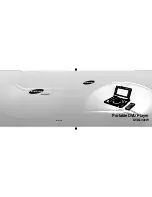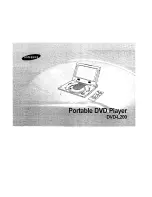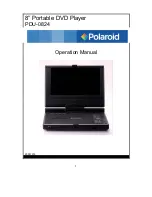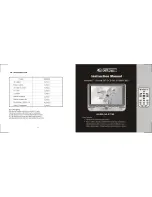
13
OPERATION
Starting the Engine Cont’d.
Stopping the Engine Cont’d.
NOTE
Observing frost on LPG containers and regulators
is common during operation and normally is not
an indication of a problem. As LPG vapourizes
and travels from the tank to the generator engine
it expands. The amount of frost that forms can be
affected by the size of the container, the amount of
fuel being used, the humidity of the air and other
operating conditions. In unusual situations this
frost may eventually restrict the flow of gas to the
generator resulting in deteriorating performance.
For example, if the tank temperature is reduced
to a very low level then the rate at which the LPG
vaporizes is also reduced and may not provide
sufficient fuel flow to the engine. This is not an
indication of a problem with the generator but
only a problem with the flow of gas from the LPG
container. If generator performance seems to be
deteriorating at the same time that ice formation is
observed on tank valve, hose or regulator then some
actions may be taken to eliminate this symptom.
In these rare situations it can be helpful to reduce
or eliminate the cold fuel system effects by doing
one of the following:
– Exchanging fuel tanks to allow the first tank to
warm up, repeating as necessary
– Placing the LPG container at the end of the
generator near the handle, where engine fan air
flows out from the generator. This air is slightly
heated by flowing over the engine. The container
should not be placed in the path of the muffler
outlet.
– The container can be temporarily warmed by
pouring warm water over the top of the tank.
Connecting Electrical Loads
1. Let the engine stabilize and warm up for a few
minutes after starting
2. Plug in and turn on the desired 100/200 Volt AC
single phase, 50 Hz (60 Hz) electrical loads.
– DO NOT connect 3-phase loads to the generator.
– DO NOT connect 60 Hz (50 Hz) loads to the
generator.
– DO NOT overload the generator.
Connecting a generator to your electric utility company’s
power lines or to another power source may be against
the law. In addition this action, if done incorrectly, could
damage your generator and appliances and could cause
serious injury or even death to you or a utility worker who
may be working on nearby power lines. If you plan to run a
portable electric generator during an outage, please notify
your electric utility company immediately and remember
to plug your appliances directly into the generator. Do not
plug the generator into any electric outlet in your home.
Doing so could create a connection to the utility company
power lines. You are responsible for ensuring that your
generator’s electricity does not feed back into the electric
utility power lines.
If the generator will be connected to a building electrical
system, consult your local utility company or a qualified
electrician. Connections must isolate generator power from
utility power and must comply with all applicable laws and
codes.
NOTE
Stopping the Engine
1. Turn off and unplug all electrical loads. Never start
or stop the generator with electrical devices plugged
in or turned on.
2. Let the generator run at no-load for several minutes
to stabilize internal temperatures of the engine and
generator.
3. Turn the Petrol Fuel Valve to the “OFF” position if
operating by petrol.
4. Turn the LPG cylinder knob to the “CLOSE” or off
position if operating by LPG.
5. Let the engine run until fuel starvation has stopped
the engine. This usually takes a few minutes.
6. Press the ignition switch to the “OFF” position.
7. Turn battery switch to the “Off” Position.
Important:
Always ensure that the Fuel Valve and the
Ignition Switch are in the “OFF” position when the
engine is not in use.
When turning off the generator after LPG operation, make
sure the LPG cylinder knob is in the fully closed position.
NOTE
If the engine will not be used for a period of two (2) weeks
or longer, please see the Storage section for proper engine
and fuel storage.
NOTE
EN
Summary of Contents for CPG5500E2DF-J
Page 2: ......
Page 21: ...19 Champion Generator 5500W JP...
Page 22: ...20...
Page 23: ...21 GFCI 91 4 cm 3 1 5 m 5 JP...
Page 24: ...22...
Page 25: ...23 OFF LPG LPG LPG PG OFF LPG LPG LPG LPG LPG 2 LPG LPG LPG LPG JP...
Page 26: ...24 1 2 3 1 2 3 4 R 5 2 1 2 1 2 3 1 2 1 2 2...
Page 28: ...26 10 30 1 2 3 4 5 6 4mm 6 4mm 6 85 6 4 mm...
Page 29: ...27 OPD LPG 12 AWG 2 052mm 3 309mm2 1 8kg 10kg LP LP LPG 1 2 LPG LPG LPG 3 4 LPG 5 LPG JP...
Page 30: ...28 1 5m 91 4cm 1 CSA UL1449 AC...
Page 34: ...32 1 2 3 1 2 1 1 2 3 4 5 6 7 5 6...
Page 35: ...33 1 2 3 4 5 6 7 1 2 3 4 0 7 0 8 mm 5 6 7 0 7 0 8 mm 0 028 0 031 in 1 15 mm 2 3 4 5 6 1 2 JP...
Page 36: ...34 25 PSI 1 2 3 4 5 6 25PSI 8 5 50 100 250 3 LPG...
Page 37: ...35 14 1 20 1 2 3 4 5 6 7 8 9 14 8mL 1 2 10 11 OFF 2 1 1 2 M5 10 M5 3 1 2 4 1 5 1 JP...
Page 38: ...36 OFF ON LPG AC AVR AVR https www youtube com watch v olRvvKBIyN0...
Page 46: ......
Page 47: ......
Page 48: ...814 0714 6 23 18...
















































